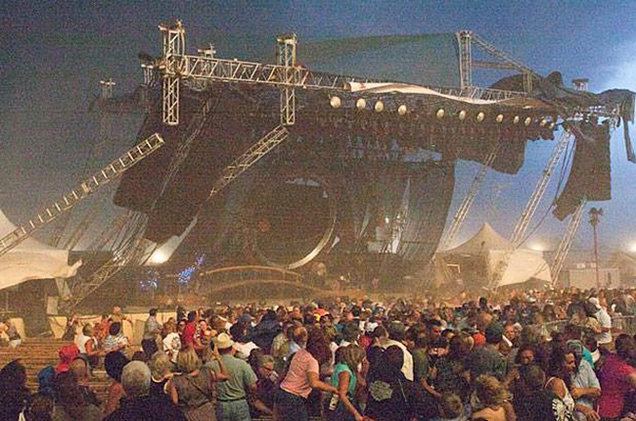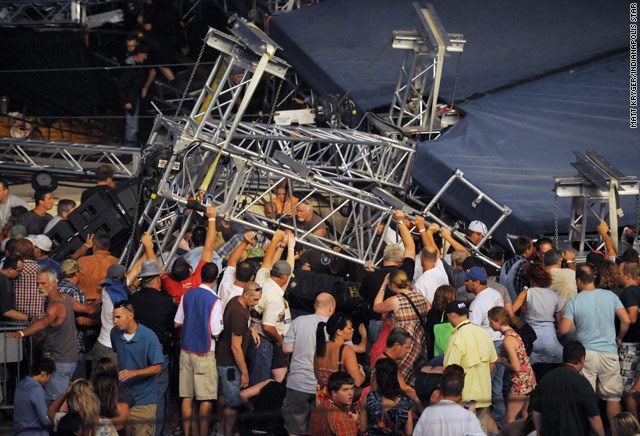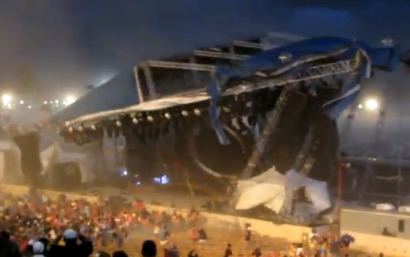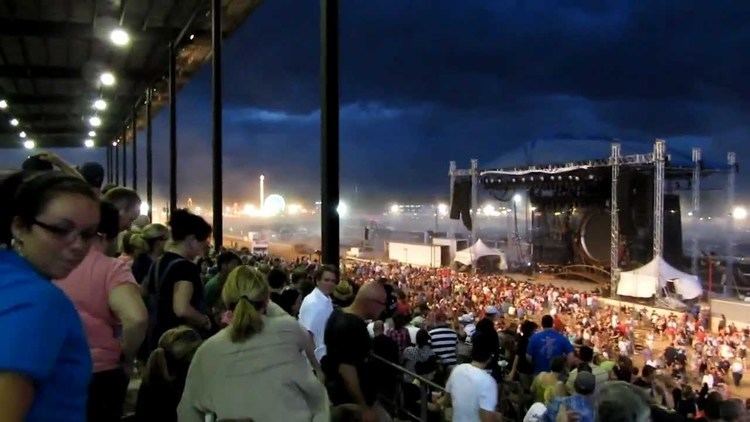Time 8:46 PM Date 13 August 2011 Injuries 58 | Non-fatal injuries 58 Total number of deaths 7 Location Indianapolis | |
 | ||
Cause Inadequate capacity of lateral load resisting system. Location Indianapolis, Indiana, United States | ||
Nbc nightly news officials investigate indiana state fair stage collapse
The Indiana State Fair stage collapse was an incident during an August 13, 2011, outdoor concert by Sugarland at the Indiana State Fair in which a wind gust from an approaching severe thunderstorm hit the stage's temporary roof structure, causing it to collapse. The structure landed among a crowd of spectators, killing seven people and injuring 58 others.
Contents
- Nbc nightly news officials investigate indiana state fair stage collapse
- Slow motion enhanced footage indiana state fair stage collapse
- Discussions about delaying the show
- Evacuation announcement and concert cancellation
- Collapse
- Investigation
- Cause of the collapse
- Design construction and inspection
- Preparedness communication and response
- Legal cases
- References

The members of Sugarland were in a tour bus preparing to come on stage when the collapse occurred at 8:46 p.m. Opening act Sara Bareilles had completed her performance prior to the incident.

Slow motion enhanced footage indiana state fair stage collapse
Discussions about delaying the show

Throughout the day and evening of the concert, the National Weather Service issued notices and warnings predicting strong thunderstorms. Messages about the forecasts were relayed to various State Fair personnel via an automated text-messaging system.

At 8:00 p.m., Cindy Hoye, Executive Director for the Indiana State Fair Commission, held a meeting to discuss what effect the weather forecast would have on the 8:45 p.m. start time for the Sugarland show. Members of the meeting were told that the storm was forecast to arrive at 9:15 p.m., 30 minutes after the concert was to begin. Hoye wanted to delay the show until the weather had passed.

An official took this message to Sugarland's managers, who said they preferred to go on with the show as scheduled and only stop if weather conditions worsened. The managers only knew about the rain, not the lightning, wind, and hail that were expected. They decided to start the show just 5 minutes late (8:50 p.m.) to allow the band time to warm up.
When the band's decision got back to Director Hoye, she accepted, assuming the band had the final say. Since the storm was to arrive at around 9:15 p.m., there would still be time for them to perform some of the show.
Evacuation announcement and concert cancellation
At around 8:30 p.m., Director Hoye encountered State Police Captain Brad Weaver. Weaver was concerned that the approaching weather would pose a threat to public safety, and recommended that Hoye cancel the show. He also recommended they put together an evacuation plan for the crowd. Hoye directed her staff to make preparations for an evacuation.
At 8:39 p.m., the National Weather Service issued a severe thunderstorm warning indicating that hail with a diameter of 1 inch (25 mm) and winds over 60 miles per hour (97 km/h) were expected. This warning was not communicated to Executive Director Hoye or Captain Weaver, who were still anticipating the storm arriving at 9:15 p.m.
At 8:40 p.m., Director Hoye dictated a message to an announcer, who delivered it to the audience at 8:45 p.m. The announcer stated that a storm was approaching but that the show would go on. He gave instructions on how to evacuate to the buildings nearby in case conditions got worse, but there was no directive to actually proceed with an evacuation.
Collapse
After hearing an announcement that the show was going to continue, Captain Weaver confronted Director Hoye and reiterated that the show should be called off. The two agreed, and began walking to the stage to make a second announcement. However, at 8:46 p.m., the stage structure collapsed—before they were able to announce the evacuation.
Tammy Vandam, 42; Glenn Goodrich, 49; Alina BigJohny, 23; and Christina Santiago, 29, all died at the scene. Stagehand Nathan Byrd, age 51; Jennifer Haskell, 22; and Meagan Toothman, 24, later died in the hospital from their injuries.
Investigation
The Indiana State Fair Commission hired the engineering firm Thornton Tomasetti to lead the technical investigation into why the stage collapsed. The same firm investigated the collapse of the World Trade Center on 9/11 and also investigated the Interstate 35W bridge collapse in Minneapolis.
In addition, the public safety and crisis management firm Witt Associates was hired to investigate the State Fair's preparedness and response to the incident. James Lee Witt, the company's CEO, was the director of the Federal Emergency Management Agency (FEMA) for the Clinton Administration.
Cause of the collapse
According to the final incident report released by Thornton Tomasetti:
The failure ... was due to the inadequate capacity of the lateral load resisting system, which was comprised of guy lines connected to concrete "Jersey barrier" ballast.
The concrete barriers used as anchors for the guy lines were not fixed in place; they resisted loading only by friction with the ground and through their own weight—about 4,200 pounds (1,900 kg). Just before the collapse, wind loading caused several of the barriers to slide or pivot from their original positions, allowing the top of the truss structure to lean toward the crowd. The subsequent bending forces within the support columns were too large, and the structure collapsed under its own weight. Measurements indicated that the total weight was 70,000 pounds (32,000 kg).
Multiple components within the lateral load resisting system were found to be insufficient:
The separation and billowing of the roof tarp was found not to be a cause of the collapse, because the collapse sequence had already begun before the membrane added additional forces.
Design, construction, and inspection
The report also points out a number of procedural factors that either contributed to the structural problems or prevented them from being discovered:
Preparedness, communication, and response
Several issues were found with the level of preparedness and the actions of State Fair officials and Sugarland representatives on the evening of the incident that contributed to the number of casualties:
Legal cases
At least four legal cases have been instigated as a result of the collapse. One case seeks unspecified damages from Sugarland, stage riggers and others associated with the production.
Sugarland's contract with the state fair claimed that the band had the final say over whether to cancel the performance due to weather conditions. Legal proceedings against Jennifer Nettles and Kristian Bush began in February 2014 to determine if they should be held liable for the stage collapse.
The deadline to file a legal case was two years after the date of the event and another legal case was filed just before this deadline on August 13, 2013. This case was brought by Fireman's Fund Insurance Co, the insurers of the band's musical equipment. Defendants named included: the State of Indiana, the Indiana State Fair Commission, James Thomas Engineering of Tennessee, Mid-America Sound Corp. of Greenfield, I.A.T.S.E Local 30 and several other companies that helped design the stage.
In 2014, the State of Indiana and other defendants settled these cases for $50,000,000.00. However, defendant ESG Security, Inc. (who lost one of its own in the collapse) denied liability and did not settle. On September 14, 2015, ESG won on summary judgement and was dismissed from the case. ESG was the only defendant dismissed from the case via the summary judgment process.
